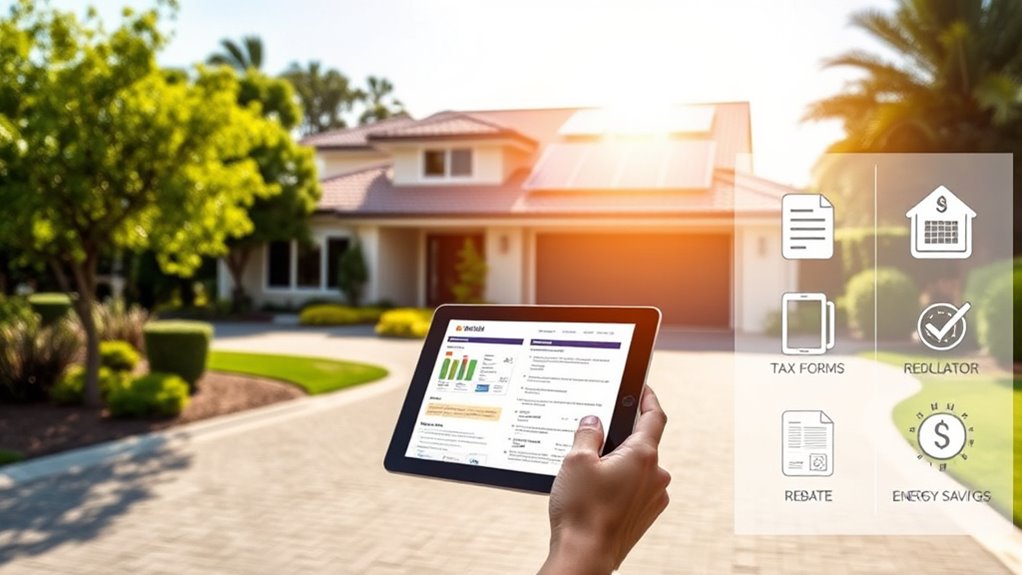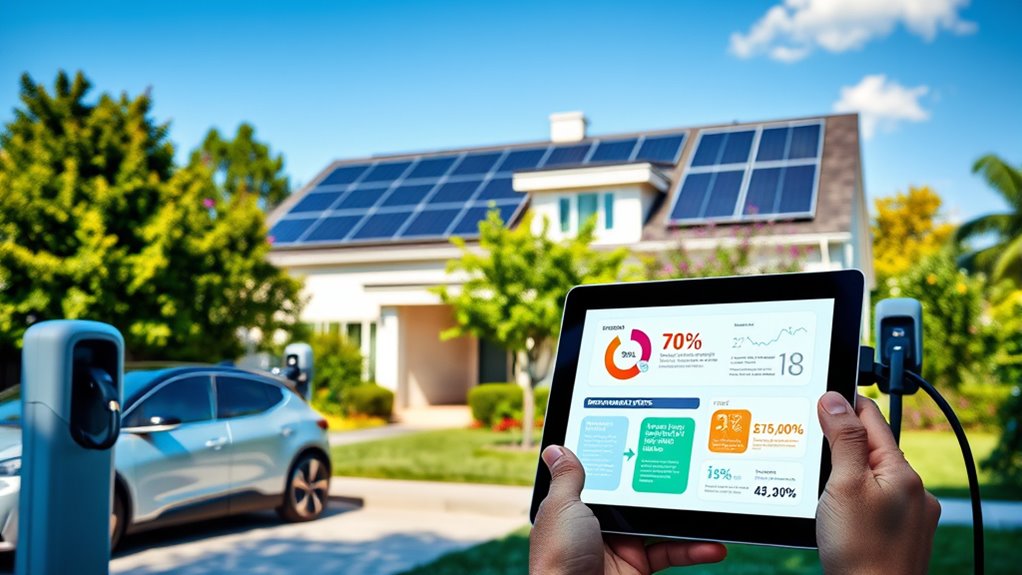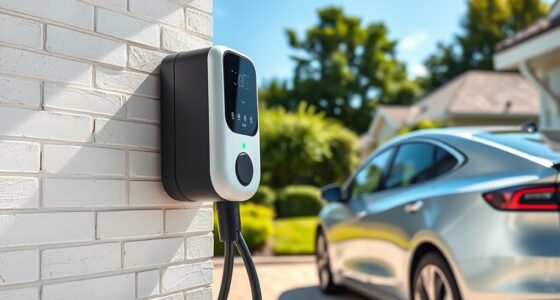To get home energy tax credits and rebates, start by upgrading your home with qualifying energy-efficient improvements like solar panels, heat pumps, or insulation after January 1, 2023. Keep detailed receipts and documentation of your projects. Claim your credits using IRS Form 5695 when you file your taxes, and look for local utility or state rebates to maximize savings. If you want to know more about step-by-step processes and strategies, keep exploring.
Key Takeaways
- Verify your upgrades qualify for federal tax credits, such as solar, geothermal, or energy-efficient windows, and keep detailed receipts.
- Complete energy improvements after Jan 1, 2023, and use IRS Form 5695 to claim your credits on your tax return.
- Maximize benefits by acting before credits decrease in 2033, and consult IRS guidelines or a tax professional for accuracy.
- Explore local, state, and utility rebates that may combine with federal credits to lower your overall costs.
- Document all expenses and certifications to ensure eligibility and simplify the rebate and credit claiming process.

If you’re looking to cut your home energy costs and make eco-friendly upgrades, understanding the available tax credits and rebates can save you money. Starting in 2023, the federal government offers a tax credit for qualified energy-efficient home improvements made after January 1st. You can claim up to $3,200 annually for upgrades like heat pumps, insulation, and other qualifying projects. This credit covers up to 30% of the costs, with specific amounts allocated to different improvements—up to $2,000 for heat pump technology and $1,200 for other qualified energy property. These credits will be available through 2032, although some may see phasedown adjustments starting in 2033.
In addition to the federal energy-efficient home improvement tax credits, you can take advantage of the Residential Clean Energy Tax Credits. These provide a 30% income tax credit for installing solar panels, solar water heaters, geothermal heat pumps, wind energy systems, and battery storage. The credit applies to both existing and new homes, encouraging you to transition toward cleaner energy sources. However, this rate gradually steps down to 22% in 2033 and 2034 before expiration, so acting sooner maximizes your benefits.
To qualify for these credits, you’ll need to verify your upgrades meet specific criteria. Solar panels, geothermal heat pumps, biomass stoves meeting EPA standards, energy-efficient windows, doors, insulation, and Energy Star-certified heat pumps or air conditioners all qualify. Keep detailed receipts and documentation of your upgrades, as you’ll need to retain proof for tax claiming purposes.
Claiming your credits is straightforward but requires proper paperwork. Use IRS Form 5695 to report your energy-efficient improvements and calculate your credits based on the percentage of your qualified expenses, up to the allowed limits. These credits directly reduce your federal tax bill dollar-for-dollar and can be claimed in the year you complete the upgrades. For accuracy, consult IRS guidelines or a tax professional to verify your eligibility and ensure proper filing.
Beyond federal incentives, many states and utility companies offer additional rebates and incentives. These programs can help cover part of your costs for HVAC upgrades, solar installations, insulation, and more. Since rules and rebate amounts vary by location, it’s crucial to check with your local energy office or utility provider beforehand. Combining federal tax credits with local rebates can considerably cut your out-of-pocket expenses, making energy upgrades more affordable. Additionally, creative problem-solving is essential when navigating complex rebate applications to maximize your benefits.
In 2023, over 100,000 households in Michigan claimed energy-efficient home improvement credits, offsetting about $80 million in expenses. Many of these households also took advantage of clean energy credits for solar and heat pumps, with an average of over $4,000 in tax relief per household. These incentives are driving increased adoption of electric heat pumps and solar panels, helping you save money while reducing your environmental impact.
Frequently Asked Questions
Can I Combine Multiple Home Energy Credits in One Year?
Yes, you can combine multiple home energy credits in one year. You’re allowed to claim up to $3,200 total, with specific limits for different upgrades like insulation, heat pumps, and windows. By spreading out your improvements or doing multiple projects, you maximize your credits. Just remember to keep all receipts and documentation, and use IRS Form 5695 to properly claim these credits on your tax return.
Are There Income Limits for Qualifying for Energy Tax Credits?
Think of the energy tax credits as a level playing field — they don’t discriminate based on income. You qualify regardless of your earnings, as long as your upgrades meet federal standards and are installed in eligible homes. There are caps on the credits and specific documentation requirements, but income limits don’t restrict your eligibility. Whether you’re earning a little or a lot, you can take advantage of these incentives.
Do I Need to Hire a Professional for Installation to Qualify?
You don’t always need to hire a professional for installation to qualify for energy tax credits, but doing so can be advantageous. Professional installation guarantees the work meets all requirements, provides necessary documentation, and maximizes your energy efficiency. Plus, certified installers can help with audit reports and compliance. If you opt for DIY, make sure to keep detailed records and consult a tax professional to verify that your improvements qualify for credits.
How Long Does It Take to Receive Rebate Payments?
Rebate payment timelines can vary because local authorities manage the process. Once your application gets approved, you might wait a few weeks to several months for the funds. Summer 2024 is when rebates are expected to start, but exact timing depends on your state’s implementation. Keep in mind, processing times differ, so stay patient and check with your local agency for updates on your specific rebate.
Are Energy Credits Available for Rental Properties?
You can’t usually get energy tax credits for rental properties unless they’re used as your primary residence. These credits are mainly for improvements on your main home, like installing energy-efficient systems or renewable energy setups. If you own a rental, you won’t qualify unless it’s also your principal residence. Always check specific eligibility rules and keep detailed records to verify your claims if you do qualify.
Conclusion
Remember, the early bird catches the worm when it comes to claiming energy incentives. By staying informed about available tax credits and rebates, you can save money and make your home more energy-efficient. Take action now—research, plan, and apply before deadlines slip away. As they say, “A penny saved is a penny earned,” so don’t leave money on the table. The effort pays off in the long run, so get started today!










